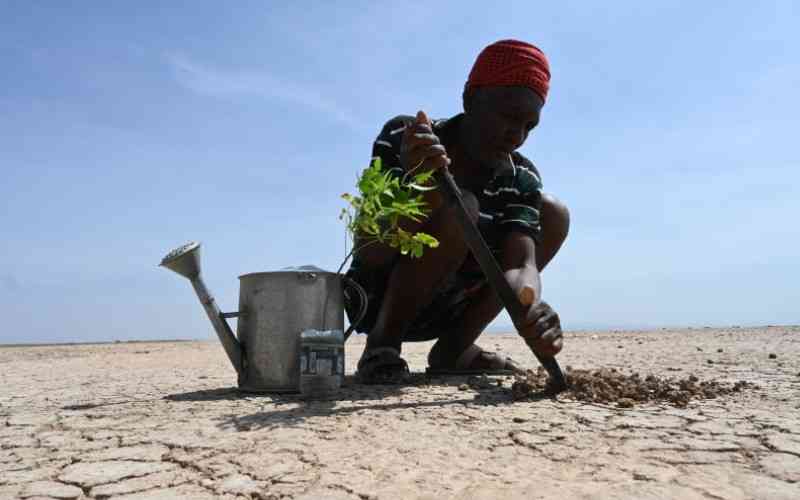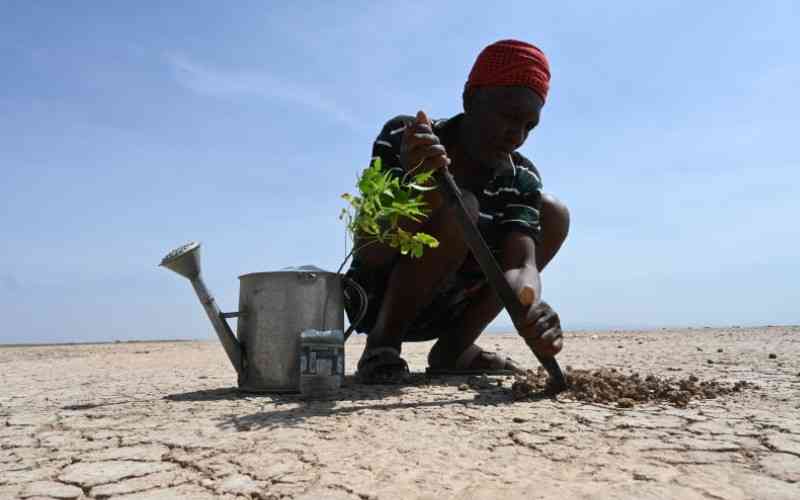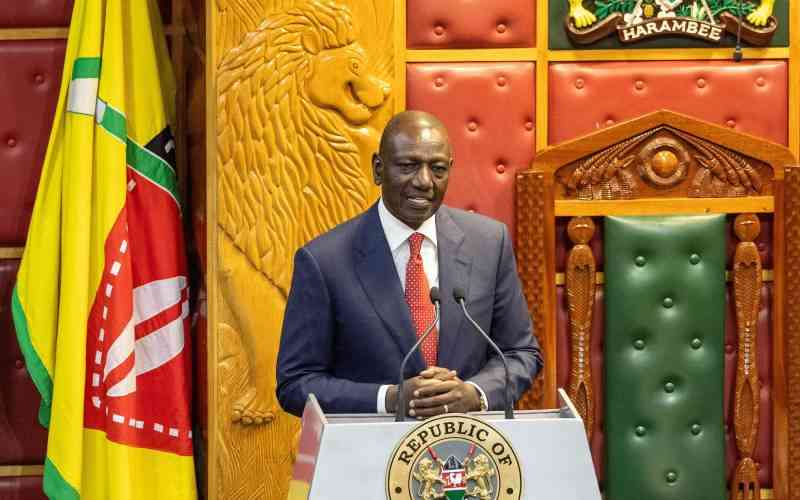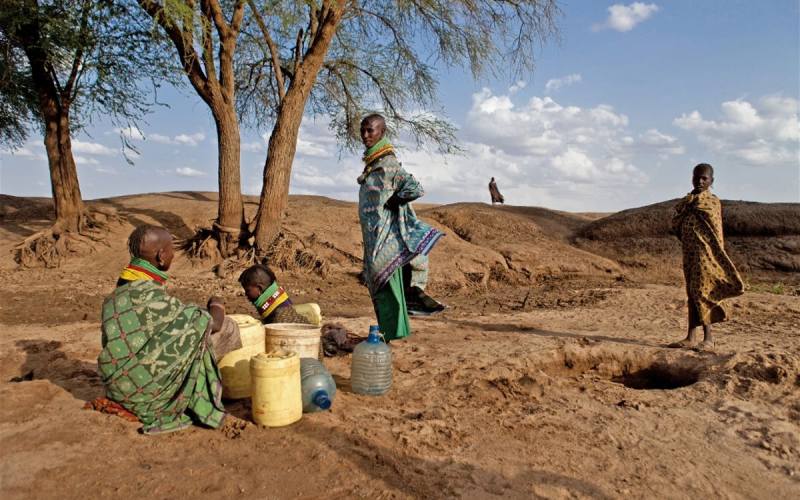
Dabaso Kantoma Sora is determined to change the face of the desert in North Horr, he is planting drought-resistant seedlings that he has given some to residents to make the desert town green including all nearby schools and in Kalacha and Maikona. [Denish Ochieng, Standard]
The Climate Change agenda has received substantive attention in the leading 2022 presidential candidates’ manifestos. This shows the candidates understand the risks the crisis poses to strategic sectors. Kenya’s Arid and Semi-Arid Lands is more than 80 per cent of the country’s land mass. Agriculture accounts for close to 30 per cent of the Gross Domestic Product (GDP) – majority being smallholder farmers, while Tourism is also a major foreign currency earner.
These key sectors of the economy are highly susceptible to climate change and disruptions in them have far reaching consequences on household incomes and government’s ability to raise revenue. A report by World Bank on climate knowledge for Kenya estimates that the impacts of drought and floods cost the country at least 3 per cent of her GDP annually. Besides, climate change effects are projected to affect several future generations, unless remedial actions are taken today.
The cost of curing these negative impacts is estimated to far outweigh the necessary investments today to mitigate the associated future global warming impacts. Thus, many governments globally consider climate change an agenda that must be driven from their highest offices.
In Kenya, the Climate Change Act, 2016 established the highest institution for climate change as the National Climate Change Council, chaired by the President. In the devolved units, the executive interventions are anchored under the climate change units domesticated under the Office of the Governor.

A boy fills his jerican with water at River Kambu, at Ngai Ndethya village, Kibwezi East, Makueni County. [Stephen Nzioka, Standard]
While the intentions are noble to anchor the climate agenda at the highest administrative levels of government, this may actually be the weakest link. Like many other policy assumptions, placing a matter at the top echelons of power implies it will get the right attention. But is this assumption necessarily correct? Suppose the holder of that office does not believe in the agenda or appreciate the enormity of it? Can the lower administrative units effectively act when no proper direction is provided from the organ vested with the highest responsibility?
For Kenya to achieve desired outcomes on climate action, we must relook two weak links, including validity of the assumption that the climate change agenda is better served under the chairmanship of the presidency, and derivation of better baseline statistics to facilitate the crafting of Specific, Measurable, Achievable, Realistic, Time-bound and Agreeable (SMARTA) goals.
There are persuasive reasons to rethink the institutional framework on the climate change agenda. While the Act was signed into law in 2016, effectively creating the institution of the Council as the apex organ, it has never met six years later. The consequences of this cannot be underestimated.
Under the climate change organogram, the Council drives the legislative agenda in climate action in the Legislature. It is also the only loop through which the independent monitoring and enforcement agency, the National Environment Management Authority (NEMA), reports to. The secretary to the Council is the Environment and Forestry Cabinet Secretary. Under the CS is the Climate Change Directorate that acts as the principle driver of climate change actions and coordinating agency, and provides secretariat to the Council. Technically, therefore, the CS would have no independent authority to drive the climate change agenda under his/her ordinary executive authority. The directorate can only deal with technical matters meant to support the council to make right policy decisions and/or implement its resolutions.
Below this structure, climate action is mainstreamed across other line ministries at the national government and through the Council of Governors for the county governments. At the counties, there is no clear evidence so far that the 47 bosses understand or have given the agenda the weight it deserves, despite the unit having been placed directly under the governor’s office.
The structure created above mirrors a corporate one, where a board drives policy and oversights organisation’s governance systems. The CS serves as the executive officer, executing the board’s decisions, coordinates all operations downstream and directs flow of information upstream to the council. Assuming this structure is a true interpretation of what the law has created, what happens when the council has never met?
Who, then, has been providing the policy direction for the past six years? Who has over-sighted the implementation of the National Climate Change Action Plan (NCCAP), 2018-2022 that is concluding this year? Who is steering the drafting of the next five year NCCAP? If the council does not meet anytime soon, will the new plan have the political goodwill that was being sought in the first place by making the President the chair of the council? If the agenda misses the political weight it deserves at the top echelons of power, would the devolved units that drive the bulk of the relevant sector activities have the momentum to act conclusively?
One of the cardinal rules in designing effective performance management systems is the derivation of smart targets. This must meet the six parameters highlighted above. The rule of the thumb is if you cannot quantify a target, assign it a time-frame and establish the relevant indicator(s), then there is no way one can measure it. A quick scan of the targets for the seven priority areas under NCCAP 2018-2022, only Forestry, Wildlife and Tourism have a quantifiable target of 10 per cent forest cover, but lack a timeline.
In his final scorecard about his 10-year term on Madaraka Day, President Uhuru Kenyatta said his target had been met. The question is whether there is objectively determined supporting evidence. A careful analysis of the way the targets have been defined and the underlying sub-themes show the country lacks any baseline data across all the priority areas. The problem with crafting targets without any baseline data is that any target set is defective ab initio for lack quantification and correctly specified indicators to measure progress.
The net effect is such defined targets could best be characterised as wishful thinking, and may never provide persuasive evidence as to whether the country is on course to achieve its national and global climate action commitments. Further, on mobilisation of resources, weak or lack of objectively verifiable evidence puts the country at a weaker position to attract international financial flows or influence policy at the global pedestal. Assuming work is in progress to develop NCCAP 2023-2027, a careful relook at how the targets are defined would be a major boost into an actionable agenda. On the Council Chairmanship, drawing lessons from this past six years could help to better house it where it can be effective and functional. Leveraging on the goodwill reflected in the candidates manifestos may offer a strategic entry point.
 The Standard Group Plc is a multi-media organization with investments in media platforms spanning newspaper print
operations, television, radio broadcasting, digital and online services. The Standard Group is recognized as a
leading multi-media house in Kenya with a key influence in matters of national and international interest.
The Standard Group Plc is a multi-media organization with investments in media platforms spanning newspaper print
operations, television, radio broadcasting, digital and online services. The Standard Group is recognized as a
leading multi-media house in Kenya with a key influence in matters of national and international interest.











